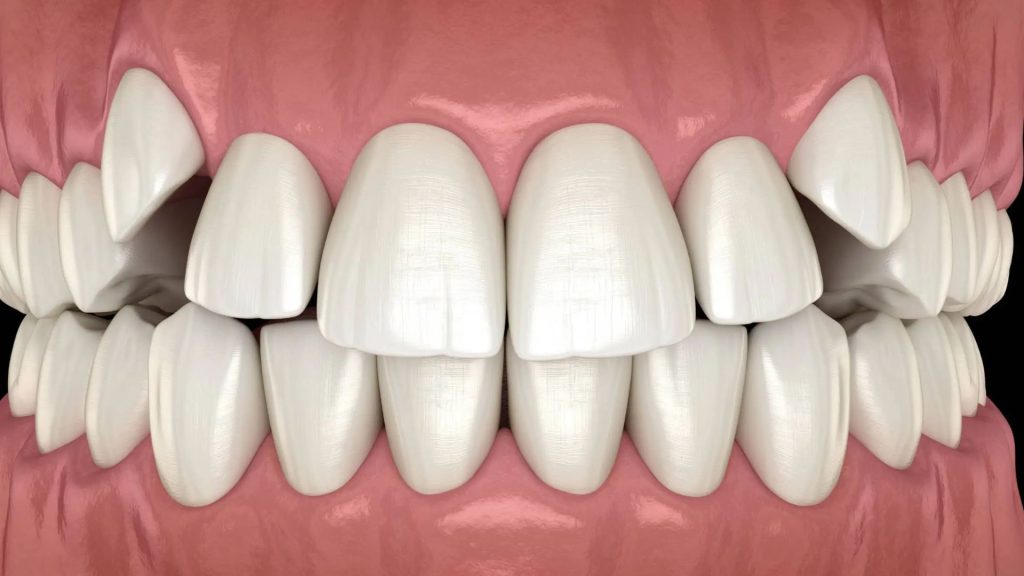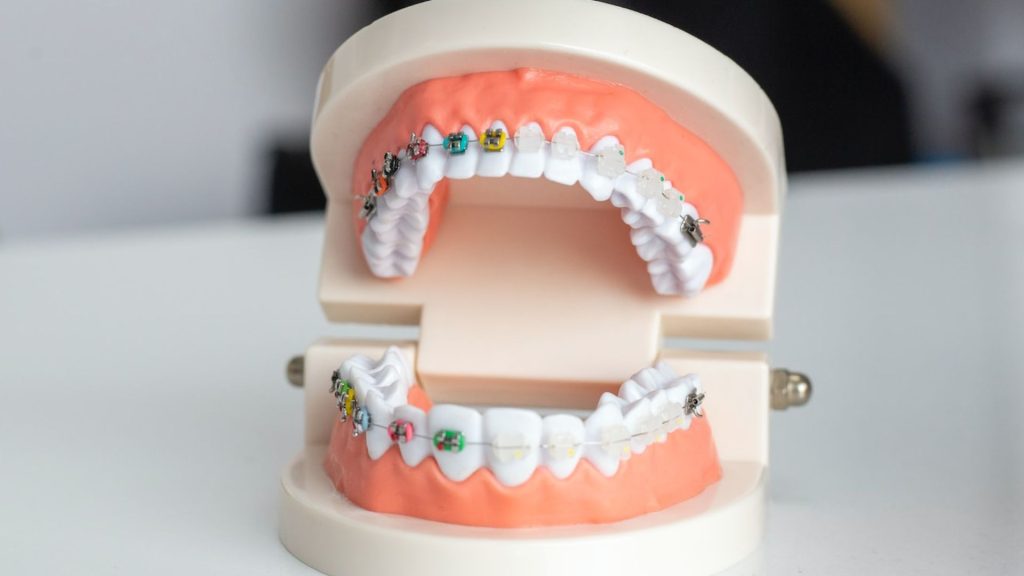Dental health is a crucial aspect of overall well-being and one common issue that many face is crowded teeth, also known as dental crowding or overcrowded teeth. Overcrowding in dentistry happens when there isn’t enough room for our teeth to line up properly. It may be caused by heredity, tooth size, or behaviors like sucking fingers or using forceps. This may make chewing uncomfortable, mouth hygiene harder, and our smiles less confident. Our teeth might grow crowded like our lives.
Many individuals struggle with “overcrowding” in dentistry. Dental science has advanced remedies for this disease, so don’t worry. When you see rows of crowded teeth in the mirror, it may be time to recognize that coming to the dentist is about more than simply smiling boldly.
What is Teeth Crowding?

Teeth crowding is a common dental condition characterized by insufficient space in the jaw, resulting in misaligned and overlapping teeth. This issue can affect individuals of all ages, from children undergoing the transition from baby to permanent teeth, to adults who may have limited space in their mouths for proper tooth alignment.
Signs Of Overcrowding

Overcrowding is a prevalent issue in dentistry and may harm our dental health and look. Seeing the signs of overcrowding is an important part of a dentist’s ability to identify and treat the problem. We may seek dental guidance and treatment for overcrowding after recognizing the indicators.
- Crowded teeth: There isn’t sufficient space between the teeth. Instead of being uniformly spaced, the teeth might overlap.
- Bite problems: Overcrowding may induce crossbite, overbite, or underbite. This may make eating hard or incorrect.
- Chewing and talking problems: When teeth are misaligned, eating and communicating may be difficult. It may impair eating and language return.
- Difficult oral hygiene: Overcrowding makes it hard to keep your teeth clean. Narrow gaps and overlapping teeth cause plaque and germs to build up, putting you at risk for gum infections, tooth decay, and other oral health issues.
What Causes Crowded Teeth?
The reason for overcrowding in dentistry is a significant issue that many individuals experience. The main factors leading to crowded teeth are disproportionately large teeth compared to the jaw size or having a small jaw. Premature loss of baby teeth is another contributing factor that can lead to dental crowding.
Seeing the signs of overcrowding is an important part of a dentist’s ability to identify and treat the problem. We may seek dental guidance and treatment for overcrowding after recognizing the indicators.
- Genetics: Overcrowding is thought to be caused in part by genetics. If the jaw size and tooth size don’t match, overcrowding might arise.
- Improper tooth size: Teeth development and size vary. If the teeth aren’t broad or deep enough, the new teeth may be crowded.
- Wrong habits: Bad behaviors cause congestion. Sucking on a button, wearing a mouthpiece, thrusting your tongue to the ceiling, and other activities may damage your teeth.
- Uneven tooth loss: When one tooth comes out later than the other, it might leave a gap and crowd growing teeth. Unreplaced tooth loss: If a tooth is lost and not replaced, adjoining teeth may crowd.
- The uneven development of the jaw muscles: In some cases, crowding and overcrowding can be caused by the uneven growth of the mouth muscles.
Benefits Of Overcrowding Treatment
Overcrowding in dentistry can enhance your look and provide other great advantages. Overcrowding therapy improves dental function and health while giving you a gorgeous smile. Discover the many advantages of overcrowding therapy:
- Improve your appearance: Overcrowding therapy boosts confidence and looks. When your teeth are correctly aligned and no longer crowded, your smile will be more even and harmonic, helping you create a good impression and feel more confident in social situations.
- Improves oral function: Overcrowding therapy improves eating and speech by repositioning teeth. You’ll chew and talk better.
- Easy oral hygiene: Overcrowding hinders oral hygiene. Aligned teeth make it easier to clean between the teeth, reducing the incidence of gum infections, cavities, and other oral health issues.
- Avoid other health problems: Overcrowding promotes bacteria and plaque growth. This may cause gingivitis, dental decay, drooping teeth, and foul breath. Treating overcrowding protects oral health and reduces the chance of these issues.
- Prevent future problems: If left untreated, overcrowding may lead to dental disease and jaw structural issues. Early overcrowding therapy may avoid these issues and preserve long-term dental health.
How to Treat Dental Crowding?

Treatment for teeth overcrowding depends on its severity and the patient’s age. Here are tailored solutions based on these factors:
Mild Crowding
Mild crowding is a slight misalignment, usually less than 3mm.
- Children (Under 18):
- Removable Appliances: Suitable for those in the early stages of jaw development.
- Braces: Traditional braces or clear aligners for short-term use; not suitable for very young children.
- Adults (18 and above):
- Clear Aligners: Invisalign is a popular choice for its discreet appearance; not suitable for those unwilling to comply with daily wear.
- Dental Veneers: Ideal for cosmetic corrections; not suitable for those with severe structural issues.
Moderate Crowding
This is a 3-6mm discrepancy in tooth alignment.
- Children (Under 18):
- Braces: Effective for realigning teeth; not suitable for those with poor oral hygiene.
- Tooth Extraction: This may be necessary for severe cases; not typically the first line of treatment.
- Adults (18 and above):
- Orthodontic Braces: Both traditional and clear aligners can be used; treatment may take longer.
- Tooth Extraction and Braces: Used for creating space; not suitable for those looking for a quick fix.
Severe Crowding
A misalignment greater than 6mm is considered severe.
- Children (Under 18):
- Orthognathic Surgery: For extreme jaw misalignment; often followed by braces.
- Comprehensive Orthodontic Treatment: Involves braces, extractions, and other interventions; requires a long-term commitment.
- Adults (18 and above):
- Surgery and Braces: Necessary for complex cases; not suitable for those unwilling to undergo surgery.
- Palatal Expander: Used to widen the upper jaw; more common and effective in younger patients.
Complex Crowding
Severe misalignment coupled with other dental issues.
- Children (Under 18):
- Comprehensive Treatment: Involving braces, possible surgery, and custom appliances; requires long-term commitment and compliance.
- Customized Appliances: Tailored to individual needs; unsuitable for those unwilling to comply with treatment plans.
- Adults (18 and above):
- Personalized Comprehensive Treatment: This may involve a combination of braces, surgery, and other interventions; requires a commitment to a potentially lengthy treatment plan.
- Ongoing Maintenance: Necessary post-treatment; unsuitable for those unwilling to maintain results.
However, the best way to manage overcrowding is to see a dentist. They’ll check you out, figure out what’s wrong, and come up with a treatment strategy tailored to you.
The Risks of Not Treating Crowded Teeth
Neglecting crowded teeth and not seeking appropriate dental treatment can lead to several complications and risks that can adversely affect both oral health and overall well-being.
Neglecting crowded teeth can lead to a host of dental and overall health issues. When teeth are crowded, they create tight spaces and overlaps that make thorough cleaning difficult, thereby increasing the risk of tooth decay and gum disease. The crowded areas provide a breeding ground for bacteria, which can lead to cavities and periodontal problems.
Additionally, misaligned teeth can result in an improper bite, making it challenging to chew food properly and potentially leading to digestive issues. This misalignment can also strain the jaw joint and muscles, possibly resulting in temporomandibular joint (TMJ) disorders, characterized by pain, headaches, and difficulties in moving the jaw.
Crowded and misaligned teeth can also impact speech, leading to difficulties in pronunciation and potential communication challenges. From an aesthetic standpoint, many people with crowded teeth may feel self-conscious about their smile, which can affect their self-esteem and confidence, and have social and professional repercussions.
The uneven distribution of pressure during biting and chewing due to crowded teeth can cause excessive wear and tear, making teeth more susceptible to chipping, cracking, and fractures. This can lead to chronic pain, discomfort, and the need for more extensive dental treatments in the future.
If these issues are not addressed in childhood or adolescence, orthodontic treatment in adulthood can be more complex, lengthy, and costly. Early intervention is crucial to mitigate these risks and ensure better oral health outcomes.
Conclusion

In modern times, having too many teeth in the mouth has become a regular problem. Not only is it annoying and painful, but it also affects our looks and mouth health. However, Spring Orchid Dental Clinic‘s tooth extraction may solve this problem. Additionally, Spring Orchid Dental offers a welcoming atmosphere. Our clinic’s friendly and attentive personnel will put you at ease as soon as you arrive. If you’re worried about the extraction, this is crucial. Finally, Spring Orchid Dental guarantees flawless, natural results. After tooth extraction, the specialists here will guarantee that your teeth are regular and balanced, giving you a brilliant and confident smile.
FAQs
Do Crowded Teeth Get Worse With Age?
Yes, if left untreated, crowded teeth might worsen with age. Several things may exacerbate crowding over time:
- Natural growth and development: As we age, our jaws develop and alter. Overcrowding might worsen if the teeth don’t fit correctly.
- Dental shifting: Teeth may move somewhat due to chewing and biting pressures. Shifting increases overpopulation and misalignment.
- Tooth wear and loss: Tooth loss and wear may also cause overcrowding. Losing a tooth might cause surrounding teeth to move and crowd.
- Gum disease: Untreated gum disease may destroy gum and bone tissue that supports the teeth. Teeth may loosen and move, causing overcrowding.
It’s crucial to remember that congestion doesn’t necessarily deteriorate with age and might stay steady. However, if you have crowded teeth, you should see a dentist and discuss treatment alternatives to avoid aggravating the situation. Your dentist or orthodontist may assess your condition and propose solutions to overcrowding and oral health.
How long do braces take to fix crowded teeth?
The duration varies depending on the complexity and the type of braces used, ranging from 6 to 24 months.
Can crowded teeth cause pain?
Yes, complications from crowded teeth, such as gum infections and cavities, can lead to pain.
Can veneers fix crowded teeth?
Veneers are an effective solution for mild cases of crowded teeth.
Can wisdom teeth cause crowding?
Yes, wisdom teeth can contribute to crowding by exerting pressure on the other teeth.
What are the advantages of Impress aligners?
Impress aligners offer a discreet, comfortable, and effective solution for correcting crowded teeth, with the added benefits of improved oral hygiene and ease of use.





